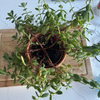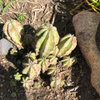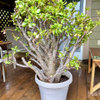Coccinia quinqueloba update
mark4321_gw
14 years ago
Sponsored
Columbus Area's Luxury Design Build Firm | 17x Best of Houzz Winner!
More Discussions
Last fall I had a few posts on Coccinia quinqueloba, a cucurbit that rapidly formed a large tuberous caudex. I figured I would follow up on some of my questions of last year.
I bought the plant in mid-July in a 4 inch pot from Annie's Annuals. I immediately repotted it in a 12 inch hanging pot and didn't notice any tuber--but I didn't look. By fall, it had become a large plant, requiring regular pruning:
{{gwi:462232}}
With a little poking I did find a tuber beneath the surface--soon the tuber started poking above the soil:
{{gwi:462234}}
I was a bit surprised when I removed some soil. I believe this was November, so only 4 months after being repotted:
{{gwi:574200}}
So the question at that point was whether I should raise the caudex. The consensus seemed to be no. So I left it alone. Apparently the plant had other plans and the caudex has risen by itself a couple inches above the level of the pot (you'll also notice that the soil level is slightly above the pot in spots). This picture was taken today:
{{gwi:574201}}
The view from above--note that I did not raise this--and you can see that the soil level is at or near the top of the pot:
{{gwi:574202}}
I also found that it was very easy to root cuttings of the plant. The obvious question was then whether the cuttings would reproduce the caudex. The answer is yes. A cutting taken last fall as it appears today:
{{gwi:574203}}
In case you are wondering, some cuttings have grown what is more a single tuber.
I just checked and it turns out I did in fact show the above rooted cutting in late December. Here it is for comparison. A Quarter is slightly less than an inch in diameter, so you can see how much bigger it is than in December:
{{gwi:574204}}
It will be interesting to see what both of those look like next December. Will the cutting be as large as the big plant was a year before? Will the big plant break its pot?
I also have Coccinia sessilifolia now (seeds from J.L. Hudson) and once it gets bigger I'll take cuttings of it as well.




cactusmcharris, interior BC Z4/5
tucson_tomato
Related Professionals
Tempe Landscape Architects & Landscape Designers · West Milford Landscape Architects & Landscape Designers · 70037 Landscape Architects & Landscape Designers · Otsego Landscape Architects & Landscape Designers · Palm Springs Landscape Architects & Landscape Designers · Framingham Landscape Contractors · Lees Summit Landscape Contractors · Southbury Landscape Contractors · Streamwood Landscape Contractors · Yuba City Landscape Contractors · Cottage Grove General Contractors · New Milford General Contractors · Universal City General Contractors · Redlands Decks, Patios & Outdoor Enclosures · Salisbury Decks, Patios & Outdoor Enclosuresmark4321_gwOriginal Author
tucson_tomato
mark4321_gwOriginal Author
cactusmcharris, interior BC Z4/5
tucson_tomato